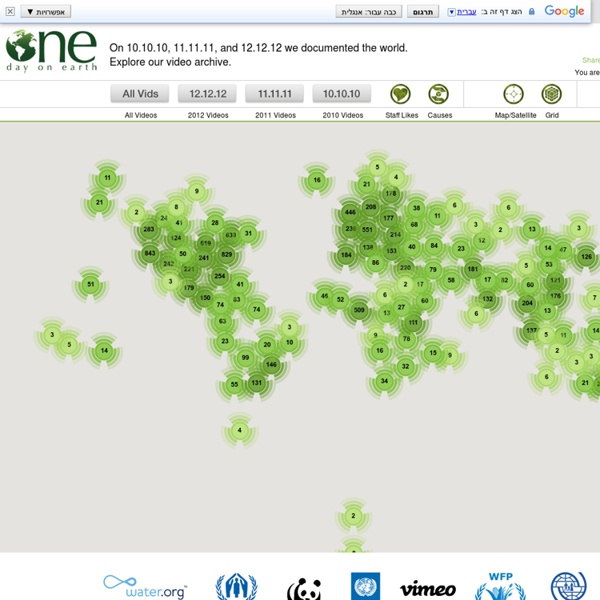



http://archive.onedayonearth.org/index.php/videos
Related: APHGMap Men: teaching geography through comedy Mark Cooper-Jones and Jay Foreman tap into a rich vein of geographical quirks to teach through comedy ‘Maps are probably the best gateway into geography,’ argues comedian Mark Cooper-Jones. ‘They have become trendy, and cool. People are even putting them up on their walls.’ For any geography teacher looking for ways to make the world’s many maps, and the various strange geographical oddities they portray, funny and yet still educational, they should definitely watch Map Men. Short, snappy videos produced and presented by comedian map-fans Cooper-Jones and Jay Foreman, Map Men explores interesting stories about maps from the UK and overseas, merging snippets of educational information with quick-fire jokes and sketches.
Penny Arcade - Transition Engineer World Spirituality News - Jan 14, 2013 We are excited to welcome you to the first edition of World Spirituality News for 2013. About twice every month this year, you will receive highlights of our latest articles, audios, videos, blog updates, and more. Our shared vision of World Spirituality based on Integral principles continues to take root in the soils of pre-modern, modern, and postmodern climates. We hope you enjoy hearing from us and share our passion for articulating and advancing a spiritual movement that is rippling across the globe in the hearts and minds of so many people. We have been busy writing, publishing, promoting, and teaching... and you can hear all about it here.
Planet Money Makes A T-Shirt Why A T-Shirt? We wanted to see the hidden world behind clothes sold in this country, so we decided to make a T-shirt. We wanted to make an ordinary shirt like the vast majority of the shirts sold in this country — not organic cotton, not hand-sewn in the United States. Meridian - Apps for Places Evolution Spirituality: Definition, Principles, History Evolution Spirituality Evolution means “the process of change,” particularly as it relates to the processes of physical change of the physical universe throughout its history. Evolution Spirituality is not just evolutionary and cosmological science where appropriate it also integrates the most life affirming wisdom from humanity's spiritual heritage to deepen the meanings discovered by the facts of science. Evolution Spirituality: 1.) embraces progressive evolutionary science and the newest discoveries of cosmology.2.) embraces and integrates the most life-affirming wisdom and tools from all of humanity's spiritual heritage to deepen the meanings discovered by the facts of evolutionary and cosmological science.3.) enhances and embraces much of what is know as today's eco-spirituality movement. 5.) is a type of omni-denominational and trans-denominational meta-spirituality and meta-religion.
'American Panorama' Is a Historical Atlas for the 21st Century When Charles Paullin’s Atlas of the Historical Geography of the United States first appeared in 1932, it was hailed as a “monument to historical scholarship.” Its 700 maps traced nearly every dimension of American life across the country’s geographical bounds—its natural history, its settlement by Europeans, the spread of railroads, state boundaries, suffrage, and much else. Paullin, a naval historian, hoped his meticulous research and beautiful renderings would inspire new research into history’s old narratives. They did. And yet for nearly a century, no other project really attempted to match its depth.
Datavisualization.ch Selected Tools Philadelphia integral development Excellent resource: the Wikipedia article. The term “Evolutionary Spirituality” was coined (as far as I know) by Andrew Cohen in this article, but the concepts go back to the early 1900s from Sri Aurobindo and Teilhard de Chardin. Cohen has developed his own version and he calls it Evolutionary Enlightenment. untitled Expectant mothers in the U.S. remain at a high risk for pregnancy-related death. (iStock) Around the globe, statistics show that as education levels for women rise, fertility levels drop. Sociologist Philip Cohen puts it this way: “Women with more education have more opportunities for productive lives doing work other than childbearing.” Some conservative writers and politicians have warned ominously that this presents a “reverse Darwinism,” and a survival of the weakest. But a new report by the Pew Research Center has found something surprising: more highly educated women in the United States are becoming mothers than ever before.
Refugee Stories: Mapping a Crisis - The Choices Program Objectives Students will: Explore the human geography of the current refugee crisis.Employ data to create a map of the crisis.Examine one refugee’s story and use it to map his or her experiences.Consider challenges facing the international community and weigh responses to the crisis. Resources Handout – Key Terms
Historic Aerials: Viewer We admit it, websites can be confusing. Especially sites as unique as Historic Aerials. If you haven't worked any mapping websites, operation might not be obvious to you. To help you scale this short (we hope) learning curve, we have compiled this list of common tasks.